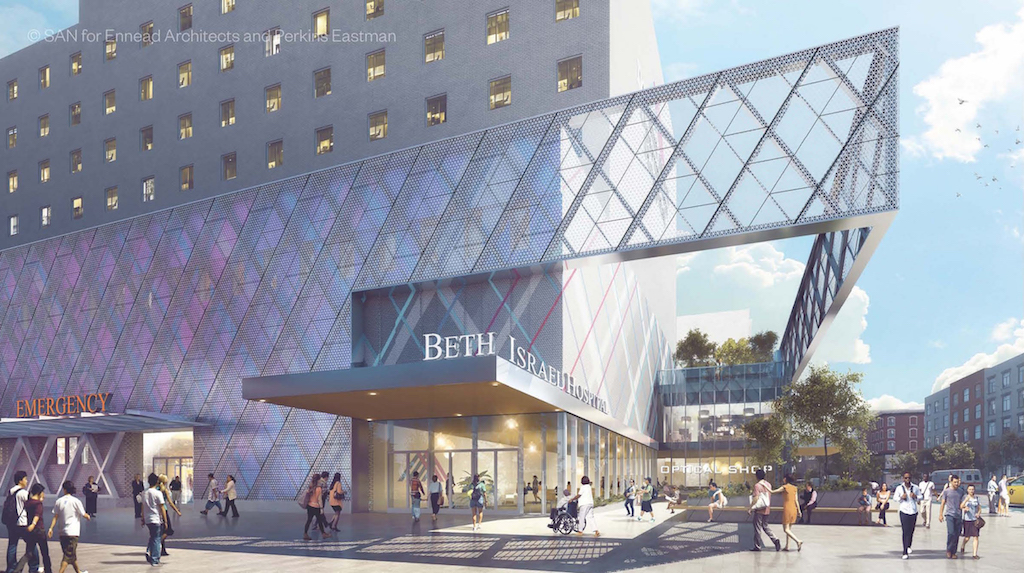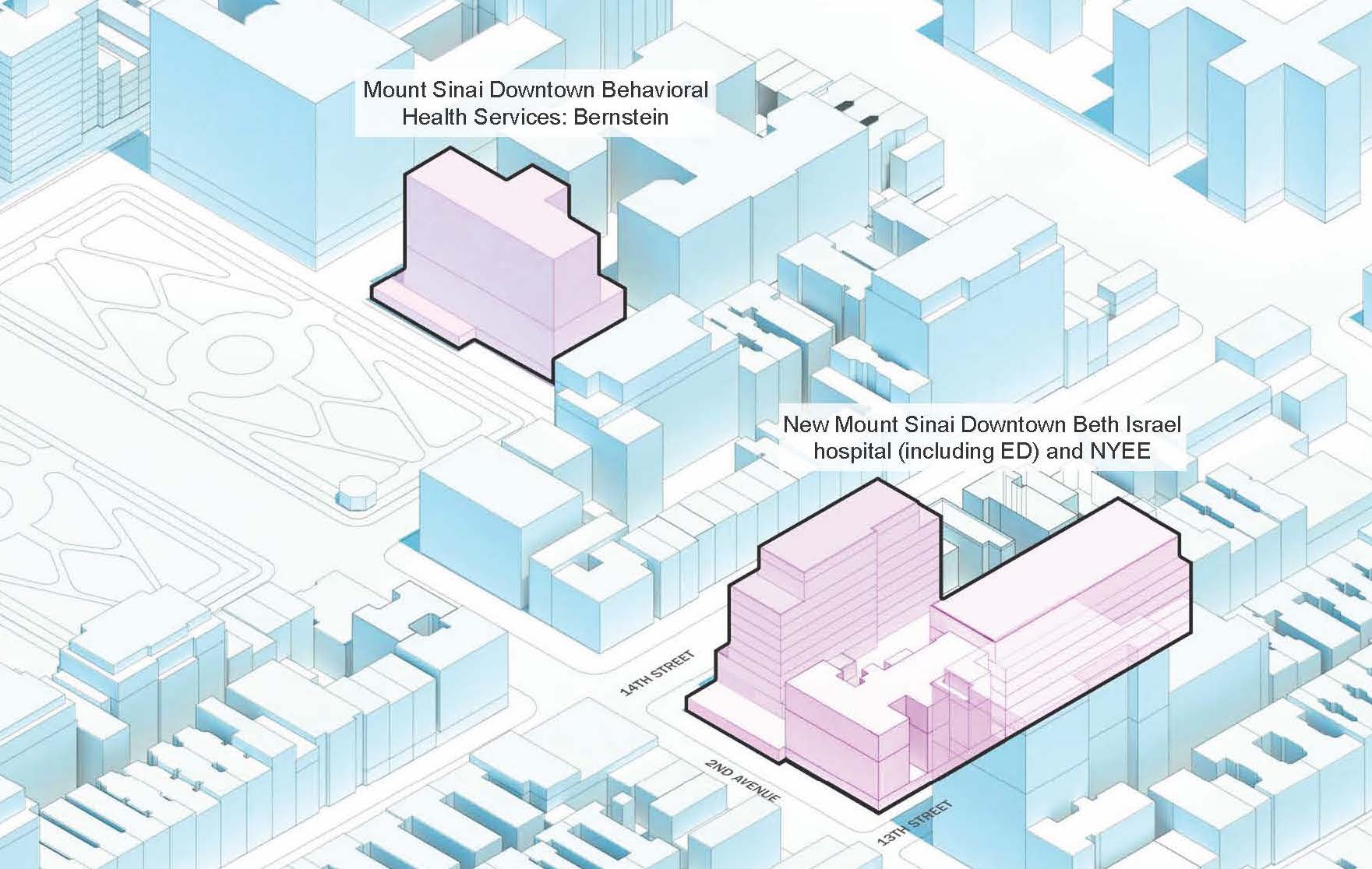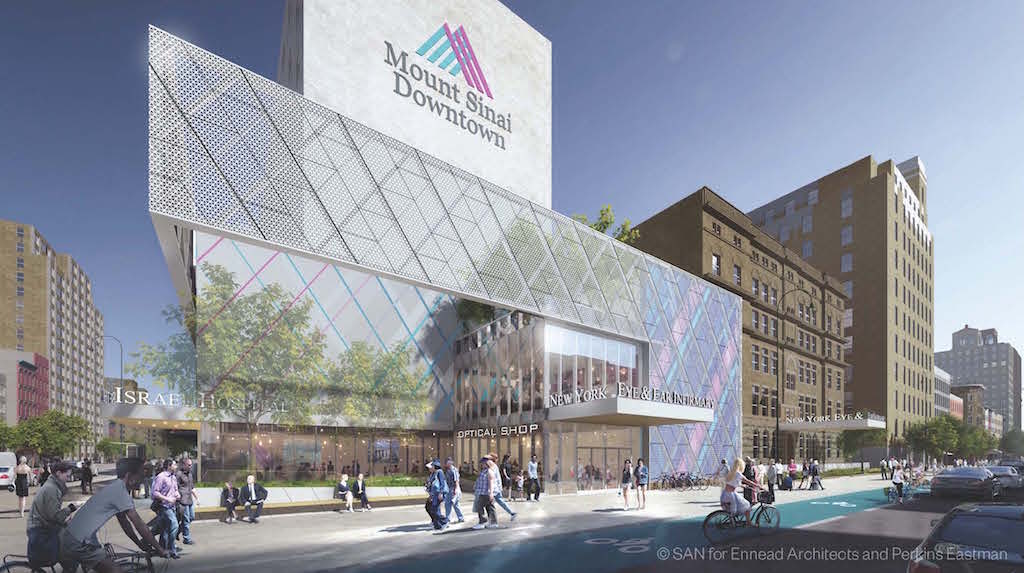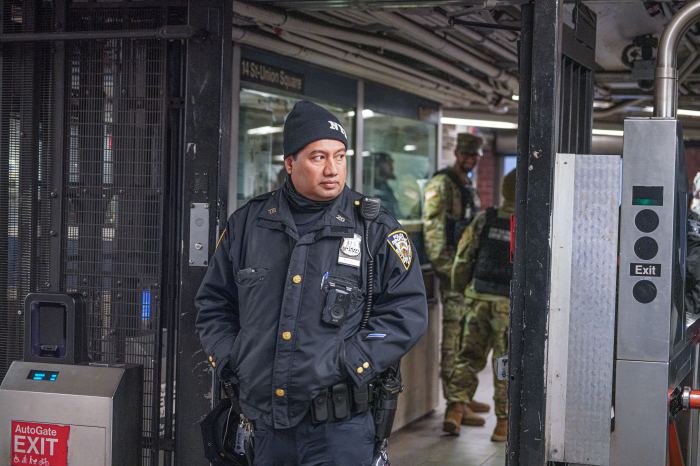BY LINCOLN ANDERSON | Mount Sinai recently announced that it has started “phase one” of its $500 million plan to rebuild Beth Israel Hospital and create a new “Mount Sinai Downtown” healthcare network.
The centerpiece of the plan, a new, smaller replacement hospital for Beth Israel — two blocks from the current hospital site — could be completed in as soon as four years from now.
This past May, in an announcement that sent shockwaves through Downtown, Mount Sinai Health System revealed that it would sell off most of its historic Beth Israel Hospital campus in Gramercy, at E. 16th St. and First Ave. and build a new, scaled-down Beth Israel at E. 14th St. and Second Ave., on part of the site of its New York Eye and Ear Infirmary.

Since that news, not much has changed about the downsizing plan. But as part of its efforts to keep the community informed, Mount Sinai Beth Israel held a community forum about the sweeping scheme on Thurs., Oct. 27, at Baruch College’s Mason Hall Auditorium, at 17 Lexington Ave. at E. 23rd St. About 100 people turned out to hear the latest presentation of the plan.
What is known so far is that the smaller East Village replacement hospital would be called Mount Sinai Downtown Beth Israel. It would have 70 inpatient beds, along with operating and procedure rooms, plus a state-of-the-art full-scale emergency department. Mount Sinai will also be keeping its 150 beds for behavioral health patients at its nearby Bernstein Pavilion on E. 16th St. at Stuyvesant Square, so stresses that it will have 220 beds “in the system.” But local residents are most concerned about the number of general inpatient beds that will be available.
The new East Village E.D. would be able to accommodate at least 70,000 visits per year, according to hospital officials. It’s still not immediately clear whether the entrance for the E.D. would be on E. 14th or E. 13th St. or where the ambulance bay would be. The hospital will stretch through the block from 14th St. to 13th St., and include the former site of an Eye and Ear Infirmary residential building and small parking lot.
Mount Sinai says the existing Gramercy hospital, most of which dates from 1927, “is too old to rebuild to bring it up to date.”
“This will be a better facility for the community,” Dr. Ken Davis, Mount Sinai Health System’s C.E.O. president, told The Villager during an interview earlier this summer.
The current Beth Israel hospital and emergency room will stay open during the new hospital’s construction.
Could add floors
In the future, if needed, both the new East Village hospital building’s number of hospital beds and the size of its emergency department could be doubled by adding two or three floors atop its E. 13th St. side, officials say. The new hospital will be constructed to allow this option.
Architects Perkins Eastman will oversee the new health hub’s design and construction. Demolition at the East Village site is expected to begin in early 2017, with construction starting in early 2018, and completion expected by late 2020.
Beth Israel is licensed for a total of 799 inpatient beds, including the 150 behavioral health beds at Bernstein. Currently, about 450 beds are used on a daily basis — including 300 general inpatient beds and, again, the 150 behavioral health beds. Half of these beds are currently filled by Brooklyn residents, a significant number of them Orthodox Jews from Williamsburg.
Beth Israel, which was founded by Lower East Side Jews, offers “automatic” kosher food (you don’t have to ask for it) and Sabbath elevators (which stop on all floors on the Jewish Sabbath without having to push any buttons), so has always had a strong connection to the Jewish community. As part of Beth Israel’s downsizing plan, Mount Sinai is looking to partner with a Brooklyn hospital to create a 30-bed site with inpatient beds and an obstetrics center that would be geared toward Brooklyn patients.
In addition, two of Mount Sinai’s other major healthcare sites south of 34th St. are also undergoing changes.
‘PACC’ upgrade
The Phillips Ambulatory Care Center — a.k.a. the “PACC” — on Union Square East is the city’s largest ambulatory care center at 275,000 square feet. It will be renamed Mount Sinai Downtown Union Square, and upgraded to become a specialized-care facility. New services will include endoscopy (scoping inside the digestive tract) and a “Respiratory Institute.” Also, in mid-2017, a new urgent-care center will open in this facility’s second floor, including pediatric care, with weekend and evening hours. Renovation work is almost finished on the place’s lobby, which will have concierge services added.
Across town, construction work to upgrade the M.S.B.I. Comprehensive Cancer Center West, at W. 15th St. and Eighth Ave., is almost finished. It will be redubbed Mount Sinai Downtown Chelsea Center. This 80,000-square-foot facility will open a new women’s cancer facility with breast cancer and gynecology oncology services. Expanded mammography services will also be offered.
In addition, the New York Eye and Ear Infirmary, between E. 14th and 13th Sts. on Second Ave., which is also part of the healthcare chain, will be preserved and upgraded. Its entrance and the entrance for the new hospital will be located 100 feet away from each other.
In all, Mount Sinai has 16 ambulatory-care sites and 600 physicians in Manhattan south of 34th St.
Behavioral health beds
Mount Sinai will eventually sell off the full-square block that Beth Israel’s main campus occupies between E. 16th and 17th Sts. and First Ave. and Stuyvesant Square. But while that parcel of prime real estate will be unloaded, the health organization will keep its current Bernstein Pavilion — for behavioral health services — one block to the south, and invest in that facility.

Although hospital bed use has dropped 10 percent annually since 2012 for other patients — through advances in ambulatory surgery and increased at-home treatment, for example — the same hasn’t held true in mental health, according to Mount Sinai. Hence the lack of reduction of Bernstein’s 150 beds.
“System-wide, citywide, beds in the behavioral-health system are at 100 percent occupancy,” a Mount Sinai representative told a joint meeting of Community Boards 3 and 6 on the Beth Israel plan earlier this summer.
This past May, a number of nurses, extremely anxious about Beth Israel’s future, called The Villager, tipping the newspaper off that Mount Sinai would be closing the iconic hospital. Fearful of retribution, they all requested anonymity.
‘An exciting time’
But Davis, the health system’s president, in the press release for the “phase one” announcement last week, assured that the overhaul is all for the best.
“Our more than $500 million investment marks an exciting time,” he said, “not only for Mount Sinai’s employees and patients, but also the entire Downtown community, as we truly transform how patients access and receive the healthcare services they need.”
Davis said as much back in June when The Villager sat down with him for an hour-long informational interview, though he required that the conversation mostly be off the record.
On the subject of staff, Mount Sinai previously had said that all union employees affected by the transformation would be offered other union opportunities at equal pay. According to Mount Sinai, so far, more than 150 employees have accepted new jobs at equal or higher salaries within its health system.
Shifting of services
As part of the transformation, some procedures and services at Beth Israel that are “highly complex” will be moved to other Mount Sinai facilities over the next 18 months.
For example, the Beth Israel cardiac surgery program will be shifted to Mount Sinai St. Luke’s, at W. 115th St. and Amsterdam Ave. However, the new Mount Sinai Downtown Beth Israel Hospital will still treat heart patients at a 24-hour cardiac catheterization lab, and will operate an emergency heart attack and stroke program. In other words, they will be able to put a stent into a person’s artery or remove a blot clot from a stroke victim’s brain.
And you will be able to have an appendectomy or your gall bladder removed at the new smaller hospital.
But joint-replacement services will be moved to Mount Sinai West (the former Roosevelt Hospital), at W. 59th St. and Tenth Ave.

And while the new M.S.D.B.I. Hospital will still offer obstetrics and gynecological services, it won’t be in the business of delivering babies anymore. Beth Israel currently handles 4,000 births per year. According to hospital officials, 2,000 of these deliveries will be shifted to the aforementioned planned new Brooklyn site, while the other half will be “distributed” among other hospitals, such as Mount Sinai and Mount Sinai West, or competitors like N.Y.U. Langone, if parents prefer. The site for the Brooklyn obstetrics center has not been set.
Boal-d new leadership
Meanwhile, Susan Somerville, the president of Beth Israel Hospital, has decided to leave her position, according to the health system.
“For over 15 years, my husband and I have had a home on the East End of Long Island,” Somerville said. “My husband has retired and I will be joining him in order to pursue new opportunities out East.”
“Susan has provided amazing leadership during several challenging years as president of Beth Israel,” Davis said, “and I truly cannot say enough good things about the job she’s done. But we understand her desire to make this transition and wish her all the best.”
On Wed., Oct. 26, Mount Sinai issued a release to all staff announcing that Dr. Jeremy Boal has been appointed president of Mount Sinai Downtown and will “lead the Mount Sinai Downtown transformation.” Prior to his new role, Boal served as chief medical officer for North Shore-LIJ Health System, now known as Northwell Health — the healthcare giant that runs the new Lenox Health Greenwich Village comprehensive care center at the former St. Vincent’s Hospital site, at Seventh Ave. and W. 12th St. Boal’s specialty is geriatric medicine.
Promise to provide info
Mount Sinai president Davis pledged that the health system would keep the community abreast of all its projects and changes Downtown.
“As our transformation moves forward, Mount Sinai remains committed to working with all employees, elected officials, local leaders and the community as the plans solidify,” he said.
Mount Sinai will provide updates on its Downtown Transformation Web site, www.mountsinai.org/downtown .
As to whether a future residential development at the current Beth Israel hospital complex in Gramercy would include affordable housing, it’s too early to know, but hospital officials said Mount Sinai, which is a nonprofit, does endorse affordable housing. All profits from the property’s sale would go toward the new Mount Sinai Downtown transformation projects, officials say.
Community concerns
Meanwhile, at the joint C.B. 3 / C.B. 6 meeting on Beth Israel’s rebuilding earlier this summer, local residents expressed great concern about the impact on the area’s healthcare. Brad Korn and Brad Beckstrom, two Mount Sinai community and government affairs officials, laid out the hospital rebuilding plan for the audience and fielded questions.
“I think a lot of us were traumatized about the closing of St. Vincent’s and Cabrini hospitals,” Mark Hannay told the two. “I freaked out when I saw the articles about Beth Israel possibly closing.”
Enrique Cruz, a C.B. 3 member, told the pair that the new E. 14th St. hospital should have at least 200 beds, not just 70. Many at the meeting were frustrated with Mt. Sinai seemingly blurring the situation by persisting on stressing that it will have 220 beds “in the system,” counting the 150 behavioral health beds at Bernstein. Again, it’s the 70 acute-care inpatient beds that residents are most concerned about.
“For 126 years, Beth Israel has been what it is and it hasn’t gone broke,” Cruz said. “Three years ago, Mount Sinai merged with this institution with the option that you were going to downsize it. And now you’re coming to us and telling us we’ve got to take it. This is a very aggressive downsizing. You’re really not leaving a lot on the bone,” he warned.
However, one of the officials reiterated the fact that inpatient stays have dropped drastically, a major reason why fewer people now need hospital beds.
“My wife is having hip replacement,” the hospital rep said. “She’s going to be in for one day. Ten years ago, it would have been a week.
“Mount Sinai will lose money on this process,” he added. “They are going to spend more to upgrade for this community than they will make on the sale [of the Beth Israel site in Gramercy].”
Who gets a big hospital?
But community members remained unconvinced.
“There’s 1,000 people coming in at Essex St.,” said one woman, referring to the Essex Crossing mixed-use mega-project.
“There’s going to be huge towers at Cherry St.,” she added of the new “supertall” residential high-rises already under construction, also on the Lower East Side.
“You’re leaving Lower Manhattan without a large hospital,” activist Luke Henry said.
Speaking after the meeting, local resident Cheryl Freeman recalled how Beth Israel, because it is outside the flood zone, could keep functioning during Sandy four years ago, unlike N.Y.U. Langone and Bellevue hospitals.
“God forbid we have another Hurricane Sandy,” she said. “You’re going to have patients shipped all over the five boroughs because the new Beth Israel won’t be able to hold them.”
In general, the future reality of healthcare will favor the rich, she predicted.
“I see it down the line, that the people with Medicaid and Medicare, we’re the ones who are going to have to be running here and there [for medical attention],” she said. “While the people in the condos will be able to lay up in the hospitals — they’ll have that luxury.”

































